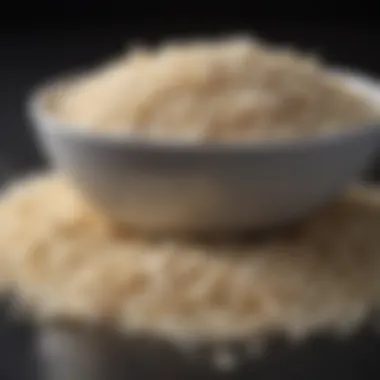Can I Feed My Dog Rice? Dietary Considerations


Intro
The role of diet in a dog’s health is a topic of great significance. Pet owners often seek the best for their furry companions. One common question arises: Can rice serve as a beneficial component of their diet? This inquiry leads to an exploration of rice's nutritional aspects, appropriate portioning, and potential risks of inclusion. While rice may seem like a harmless food, understanding its value and drawbacks is essential.
Nutrition Benefits of Rice
Rice can offer certain nutritional advantages for dogs. It is a source of carbohydrates, which can provide energy. Furthermore, rice is often easy for dogs to digest. This can be particularly useful in situations where a dog's stomach is upset. Notably, white rice is preferred in these cases, as it is less fibrous than brown rice.
Serving Sizes
When considering rice for your dog, serving sizes are crucial. Generally, a small dog may require a quarter cup of cooked rice, while a larger breed might need up to one cup. However, these amounts should be adjusted based on the dog’s total caloric intake and specific dietary needs.
Potential Drawbacks
Not everything is ideal about feeding rice. Some dogs can develop allergies or sensitivities to grains. Moreover, too much rice can lead to obesity, as it is calorie-dense. To mitigate these risks, rice should complement a balanced diet that includes protein and vegetables.
Types of Rice
Understanding the various types of rice is also important. White rice is widely recognized, but brown rice offers more fiber and nutrients. Other options include jasmine and basmati rice. Each type has its own texture and taste, influencing its acceptance by your dog.
Alternatives to Rice
If rice is not suitable for your dog, there are alternatives. Quinoa and sweet potatoes are known for their nutritional profiles and can serve as excellent carb sources. When introducing any new food, observing your dog's reaction is advisable.
In summary, rice can be a thoughtful addition to dog meals, given it is approached with care. It is vital for pet owners to remain informed about their dogs’ nutritional needs and overall health.
"Always consult a veterinarian before making significant changes to your dog's diet."
Foreword to Canine Nutrition
Understanding canine nutrition is fundamental for any pet owner aiming to provide their dog with a healthy and balanced diet. Proper nutrition affects a dog's overall health, energy levels, and can even influence lifespan. A dog's nutritional needs vary by breed, age, weight, and health status, making it essential to evaluate these factors when choosing a suitable diet.
In this context, it is worth examining different dietary components, how they interact, and their significance in daily feeding. An effective canine diet should include proteins, fats, carbohydrates, vitamins, and minerals in appropriate ratios to meet a dog's unique requirements. This article focuses on rice, a common ingredient found in various dog foods, assessing its role and implications within the broader scope of canine nutrition.
The Importance of a Balanced Diet
A balanced diet is critical for dogs just as much as it is for humans. Dogs need a variety of nutrients to maintain optimal health. These nutrients support vital bodily functions, including digestion, metabolism, and immune response.
Nutritional imbalances can lead to health issues such as obesity, diabetes, and digestive disorders. For instance, one of the key benefits of a balanced diet is that it helps to maintain a healthy weight. Overweight dogs are more susceptible to serious health problems, including joint issues and heart diseases. Overall, a proper diet improves the quality of life and can enhance a dog's longevity.
Role of Carbohydrates in Dog Diets
Carbohydrates often have a misunderstood reputation in dog nutrition; however, they play an important role. While dogs are primarily carnivores, they can derive energy from carbohydrates as well. Rice, along with other carbohydrate sources, provides essential energy required for daily activities.
Including carbohydrates in a dog's diet helps provide quick energy and can aid in digestion. In fact, many veterinarians recommend rice for dogs with digestive issues due to its digestibility and ability to help firm up stool.
Additionally, carbohydrates can be a healthy source of fiber, which contributes to proper digestive health. However, the key is moderation. Too many carbohydrates can lead to weight gain and obesity, as mentioned earlier. Thus, understanding the carbohydrate content of any ingredient, such as rice, is essential for dog owners when constructing a balanced diet.
Understanding Rice as a Dog Food Ingredient
Rice is often described as a staple of many diets around the world, and this holds true for dogs as well. The consideration of rice as a dog food ingredient is significant because it serves multiple purposes in canine nutrition. Its ease of digestibility, carbohydrate content, and palatability make it a preferred option among pet owners. Understanding the role of rice is essential to evaluate how it fits into a dog's diet and how it can enhance overall health. Moreover, rice can provide additional energy, essential for active dogs. However, it is crucial to explore this ingredient in detail, considering its benefits, types, and how it should be included in a dog’s meal plan.


Nutritional Profile of Rice
Rice offers a variety of nutrients that can support a dog’s health. It is important to examine not only the vitamins and minerals present but also the calories and macronutrients.
Vitamins and Minerals
Rice contains several vitamins and minerals that benefit canine health. Notably, it provides B vitamins, which are important for energy metabolism in dogs. Thiamine, niacin, and vitamin B6 help in converting food into energy. Furthermore, minerals like magnesium and phosphorus are found in rice, playing roles in bone and muscle function. Apart from these benefits, rice is low in sodium, making it an excellent option for dogs needing to control their salt intake.
However, it lacks some essential nutrients, and relying solely on rice can miss out on other nutritional needs of the dog.
Calories and Macronutrients
Rice is primarily made up of carbohydrates, making it calorie-dense. This gives necessary energy, especially for active breeds. White rice, for instance, contains around 130 calories per 100 grams, while brown rice has a slightly higher calorie content due to its fiber. The macronutrient composition of rice includes mainly carbohydrates, along with small amounts of protein and virtually no fat. This ratio can be helpful for dogs recovering from gastrointestinal issues, as it is easily digestible. However, it is crucial to monitor the caloric intake from rice to avoid overfeeding, which might lead to weight issues.
Types of Rice Suitable for Dogs
There are various types of rice that can be included in a dog’s diet, each with its own merits.
White Rice
White rice is commonly included in dog diets, especially when dealing with digestive issues. It is polished, removing the husk, bran, and germ. This gives it a longer shelf life and easy digestibility. White rice's primary feature is its gentle nature on a dog’s stomach, making it a go-to for pets recovering from diarrhea or vomiting. However, it lacks dietary fiber and some nutrients found in its brown counterpart, so it should not be the sole source of nutrition.
Brown Rice
Brown rice is considered a healthier alternative due to its whole grain nature. It retains the bran and germ, providing more fiber, vitamins, and minerals. This can aid in digestion and promote a healthy weight. Brown rice can also help control blood sugar levels more effectively compared to white rice. On the downside, it takes longer to cook and may not be as easily digestible for some dogs, especially those with sensitive stomachs.
Wild Rice
Wild rice, although not a true rice, is another option. It is high in antioxidants and has a unique taste that some dogs may enjoy. It also offers a good quantity of protein and provides more nutrients than white rice. The texture is chewier which can be appealing for dogs. However, it is more expensive and less common than white or brown rice, often making it a less feasible option for daily feeding.
In summary, understanding rice as a dog food ingredient is crucial in tailoring a diet that meets a pet's unique nutritional needs. By recognizing the different types of rice, the nutritional profiles, and how these elements interact, pet owners can make informed decisions for their canine companions.
Feeding Rice to Dogs: Guidelines
Feeding rice to dogs is a topic that merits careful consideration. Many dog owners wonder how rice fits into their pet's diet. The guidelines for feeding rice aim to offer clarity on portion sizes, preparation, and best practices to enhance canine nutrition. Understanding these guidelines helps dog owners make informed choices that align with their dog's unique dietary needs and health status.
Appropriate Serving Sizes
Factors Affecting Portions
When considering the appropriate serving sizes for rice, several factors come into play. The dog's age, weight, activity level, and overall health are crucial elements that influence how much rice can be included in their meals. A key characteristic of this aspect is its direct impact on your dog's well-being. For example, a highly active dog requires more carbohydrates for energy compared to a senior dog that leads a more sedentary lifestyle.
Unique features such as breed size also affect portion servings. Larger breeds might tolerate larger servings without adverse effects, whereas smaller breeds could suffer from digestive issues if overfed. Monitoring portion size based on these factors ensures that rice becomes a beneficial addition rather than a potential risk.
Regular Diet vs. Treats
Distinguishing between regular diet and treats is essential when incorporating rice into canine meals. In regular diets, rice can serve as a carbohydrate source, alongside proteins, to create a balanced meal. On the other hand, when given as treats, rice should be limited to avoid excessive calorie intake. This approach helps maintain a healthy weight and proper nutrition.
A unique feature of comparing regular diet versus treats is the frequency of feeding. Regular inclusion in daily meals can provide essential nutrients, while occasional treats allow for variety without compromising health. However, over-reliance on rice as a treat can lead to nutritional imbalances, emphasizing the importance of moderation in this article's context.
How to Prepare Rice for Dogs
Cooking Methods


The cooking methods used for rice preparation play a significant role in making it safe and digestible for dogs. It is recommended to boil or steam rice before serving it to ensure it is soft and easy for dogs to chew and digest. This basic method is beneficial as it avoids unnecessary fats and oils that can upset a dog's stomach.
Unique features of cooking methods include avoiding common but harmful practices, such as using stock or seasoning. These additives can contain sodium or other components that may be detrimental to canine health. Following simple cooking methods ensures that rice remains a safe and nutritious option for dogs, supporting the overall goal of promoting healthy feeding practices.
Avoiding Harmful Additives
A focus on avoiding harmful additives is crucial when preparing rice for dogs. Many commercial rice products may contain preservatives or flavorings that are not suitable for canine consumption. Keeping rice free from additives preserves its health benefits and maintains a focus on nutrition.
Highlighting this aspect ensures that rice is prepared in its purest form for dogs. For pet owners, understanding what to avoid protects their dog's health and mitigates the risk of digestive upset or allergies. Emphasizing the importance of clean and simple preparation aligns with the article's broader aims of guiding dog owners toward healthier choices.
Potential Risks of Feeding Rice to Dogs
Understanding the potential risks of feeding rice to dogs is critical for any pet owner. While rice can be a beneficial addition to a dog's diet, it is not free from concerns. Identifying and addressing these risks ensures a balanced approach to canine nutrition. This section addresses specific digestive health issues, long-term health consequences, and overall dietary balance when including rice in a dog’s meals.
Digestive Concerns
Allergies and Intolerances
Allergies and intolerances can emerge when feeding dogs rice. Some dogs may be allergic to rice, leading to symptoms like itching, skin irritations, or gastrointestinal distress. This means owners should monitor their dogs closely for adverse reactions after introducing rice. The presence of allergens can complicate what seems like a simple addition. Understanding this aspect is crucial for assessing if rice is a good fit, helping to avoid unnecessary discomfort for pets.
When dogs show signs of allergies, it is vital to identify the triggers. If rice proves to be one, alternatives need consideration. This can help pet owners ensure that their dog’s diet remains healthy without leaning on ingredients that can cause harm. While rice is a common grain, its role can shift based on individual reactions.
Effects of Overfeeding
Overfeeding rice poses another significant risk for dogs. Rice is high in carbohydrates, and too much can lead to weight gain and other health problems. Dogs, unlike humans, do not require excessive carbohydrates in their diet. Monitoring serving sizes is essential. An increase in rice, especially as a regular part of the diet, can disrupt their nutritional balance.
The unique feature of overfeeding is that it often goes unnoticed until weight gain becomes apparent. This can lead to further health complications, such as diabetes and joint issues. It is important to maintain a balanced diet, where rice serves rather as a supplement rather than a staple.
Impact on Long-term Health
Nutritional Deficiencies
Nutritional deficiencies can arise from a diet overly dependent on rice. While rice provides some carbohydrates, it lacks essential vitamins and minerals crucial for overall canine health. Long-term reliance on rice as a major ingredient may lead to gaps in nutrition. Pets require a varied diet to thrive, particularly one rich in proteins and fats.
The core problem is that rice does not supply all necessary nutrients. Some owners might mistakenly believe they are offering a balanced meal by including rice, neglecting the need for other dietary components. This oversight may lead to health issues over time. To avoid deficiencies, it is important to complement rice with a diverse selection of dog-friendly foods.
Weight Management Issues
Weight management issues are closely related to improper feeding practices. Since rice is calorie-dense, excessive consumption can lead to obesity. This is especially concerning in less active dogs. Weight management involves ensuring dogs maintain a healthy weight while still being free to enjoy various flavors in their meals.
The main consideration here is portion control. Keeping rice as a small part of a dog's overall diet can help maintain a healthy weight. It may be tempting to give more rice for perceived benefits, but this can backfire. Awareness and careful planning are the keys for dog owners to achieve a well-rounded and supportive diet.
Alternatives to Rice in Dog Diets
Considering alternatives to rice in a dog's diet is essential. Many pet owners explore diverse carbohydrate sources and protein-rich options to ensure balanced nutrition. While rice may provide some benefits, examining substitutes can enhance dietary variety and meet the specific needs of different dogs. This section presents several alternatives that could serve as viable replacements for rice while offering unique nutritional benefits.
Other Carbohydrate Sources
Quinoa
Quinoa is a remarkable substitute due to its complete protein profile. It contains all nine essential amino acids, making it a valuable source of nutrition for dogs. Quinoa is also rich in vitamins such as B and E, as well as minerals like magnesium and iron. Its high fiber content promotes healthy bowel movements, which can be beneficial for dogs prone to digestive issues. However, pet owners should note that quinoa must be thoroughly rinsed before cooking, as the outer layer—known as saponin—can be bitter and potentially harmful. Overall, quinoa is a beneficial choice that can enhance dietary variety in dogs.


Oats
Oats are another option that pet owners often consider. They are rich in soluble fiber, which aids in regulating blood sugar levels and maintaining heart health. Additionally, oats contain antioxidants, which contribute to overall wellness. The unique feature of oats is their ability to absorb moisture, which can help keep dogs hydrated when included in meals. However, it is important to introduce oats gradually as some dogs may experience mild digestive upset if not accustomed to high-fiber foods. Since oats are generally well tolerated, they can be a nutritious and affordable substitute for rice in dog diets.
Protein-Rich Alternatives
Legumes
Legumes, including lentils and chickpeas, are excellent protein sources that can diversify a dog’s diet. They provide high-quality proteins while being low in fat, which is beneficial for weight management. Additionally, legumes are packed with fiber and various vitamins that contribute to a dog's overall health. However, caution should be exercised when feeding legumes, especially if your dog has a history of digestive sensitivity or flatulence. When prepared properly, legumes are a beneficial supplement to a canine diet, offering both protein and essential nutrients.
Meat Options
Including meat options in a dog's diet is fundamental for meeting their protein requirements. Various meats, such as chicken, beef, and fish, contribute essential amino acids necessary for growth and energy. Meat is also rich in vitamins and minerals, including B vitamins and zinc, which support immune function and muscle development. It’s important to select high-quality protein sources, as not all meats are created equal. Additionally, be mindful of how the meat is prepared—avoiding excessive fats and harmful seasonings is crucial. Overall, meat serves as a staple in canine diets due to its complete nutritional profile and palatability.
Expert Opinions on Feeding Rice to Dogs
Integrating professional insights into canine nutrition can shed significant light on the question of rice in a dog's diet. Understanding veterinary and pet nutritionists’ perspectives allows dog owners to make informed choices regarding this staple food. Veterinary insights are particularly valuable for addressing potential health concerns while pet nutritionists offer guidance on optimal dietary composition. Both viewpoints emphasize the need for a comprehensive understanding of rice as a potential dietary component for dogs.
Veterinary Insights
Veterinarians play a crucial role in assessing what is best for our canine companions. They provide evidence-based recommendations that consider overall dog health. When it comes to rice, many vets acknowledge its benefits, especially during recovery from gastrointestinal distress. White rice is often suggested following digestive issues due to its blandness and digestibility.
However, veterinarians also caution about over-reliance on rice. They point out that while rice can be part of a balanced diet, it should not entirely replace essential nutrients found in more varied dog food options.
"Rice is easy on a dog's stomach, but it lacks many vitamins and minerals that dogs require for overall health."
— A veterinarian’s assessment
To maintain a balanced diet, dog owners should incorporate other nutrient-rich ingredients alongside rice. That's vital for ensuring dogs retrieve their daily calories from multiple food sources that promote a harmonious balance of nutrients necessary for their health.
Pet Nutritionist Recommendations
Pet nutritionists specialize in understanding dietary needs in pets. They advocate for informed and varied diet plans that enhance a dog's overall nutrition. From a nutritionist's standpoint, rice can serve as a beneficial carbohydrate source when administered in moderation. They recommend keeping an eye on dogs' energy levels and weight while feeding rice, particularly for less active or older dogs who may not metabolize it as effectively.
Nutritionists also suggest that brown rice might offer more health benefits. It has higher fiber content and additional nutrients compared to white rice. However, they remind dog owners that introducing any new food should be gradual to monitor any possible adverse reactions.
In summary, the viewpoints expressed by veterinarians and pet nutritionists together form a solid foundation for understanding rice's role in dog diets. Listening to these experts helps pet owners navigate dietary choices in a way that prioritizes their dog's health, well-being, and enjoyment of food.
Ending: Making Informed Choices
In determining whether rice is a suitable addition to a dog’s diet, it is essential that pet owners make informed choices. The relationship between diet and the overall wellbeing of dogs is significant. Understanding the implications of including rice in their meals is necessary for several reasons. First, it aids in meeting the specific dietary needs of individual dogs. Each dog has a unique nutritional profile based on factors such as age, weight, activity level, and health status.
Additionally, understanding these needs will direct owners toward feeding practices that promote long-term health. It is not only about what is served, but how it fits into the bigger picture of their overall meal plan. Rice can be a beneficial component of many dogs’ diets, providing energy and aiding digestion, yet it must be accompanied by a careful assessment of other nutritional elements.
"A balanced approach to a dog's diet is vital for sustaining their health and energy levels throughout their lives."
Moreover, the choices surrounding rice involve considerations on preparation methods, serving sizes, potential allergens, and alternative sources of nutrition. Each factor plays a crucial role in ensuring dogs maintain a healthy weight and avoid developing deficiencies or health complications.
Evaluating Your Dog's Unique Needs
Evaluating a dog’s unique needs requires a thorough understanding of their specific health condition and lifestyle. Owners should consider the dog's breed, age, and any dietary restrictions that may apply. Consultation with a veterinarian can also provide a clearer picture. For example, active dogs may require higher carbohydrates to support their energy levels, while older dogs may need a nutrient-dense diet to combat signs of aging.
It's important to observe how a dog responds to any new food, including rice. Signs of discomfort may indicate an intolerance or allergy, which can affect decisions about their diet. Keeping a food diary can also help in monitoring what suits them best.
Final Recommendations
The choice to incorporate rice into a dog’s diet should be made with careful thought and consideration. Here are several recommendations:
- In moderation: Rice should complement a diet rich in proteins and fats, not replace them.
- Balanced meals: Ensure that rice is served alongside other nutrient-rich foods, providing a comprehensive nutrition profile.
- Consult with experts: Engage with veterinarians or pet nutritionists to tailor the diet specifically for your dog.
- Monitor for changes: Keep an eye on your dog's health after introducing new foods. Weight fluctuations or digestive issues should be noted.
Ultimately, dogs thrive on a varied and balanced diet. By understanding their unique dietary needs and making informed choices, dog owners can support their pets' health and happiness effectively.







